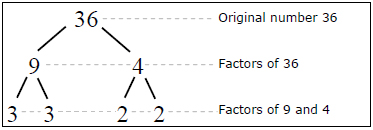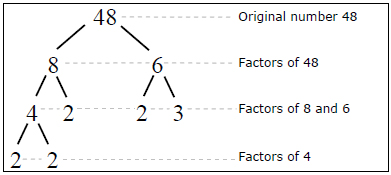
 |
|
|
|
A Factor Tree Makes Factoring EasyAn easy was to factor a number is by making a factor tree. To make a tree, simply write the number you want to factor at the top of your paper.
Here is an example of how to factor the number 36:
Now we can easily see the factors of 36 are 3, 3, 2, and 2. All this means is that if you take those numbers and multiply them together: 3(3)(2)(2) = 36. We can also write this in a fancier wasy using exponents: 36 = 22•32 Factoring is the the process of breaking a part a multiplication problem. Please note: You did not have to choose 9 and 4 as the first two "branches" of the tree. You can pick any two numbers that multiply to make 36. Other possibilities are 6 & 6, 3 & 12, and 2 & 18.
Here is an example of how to factor the number 48:
In exponent form you have: 48 = 24•3
For more great factoring tips, return from factor tree to how to factor.
|
| . | ||
| Home │ Site Search │ Math Help Blog │ Help Keep GradeA Free | |
Written by Team GradeAmathhelp.com, all rights reserved. | ||

